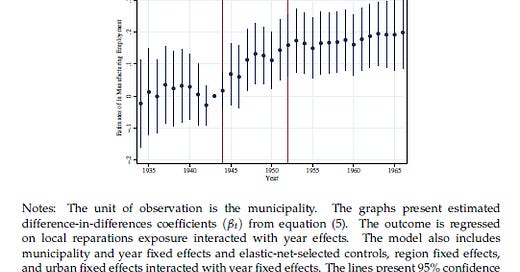Industrial Policy, Structural Change, and Intergenerational Mobility: Evidence from the Finnish War Reparations
Author: Matti Mitrunen
Abstract: This paper investigates the long-term impacts of large-scale industrial policy on industrial and local development as well as on individual outcomes. From 1944 to 1952, mostly agrarian Finland had to export 4% of its yearly GDP in industrial products to the Soviet Union as war reparations. To meet the reparation demands, the Finnish government needed to provide extensive but temporary support to the Soviet assigned industries with insufficient production capacity. I show that this exogenously determined short-lived government support persistently and significantly raised the employment and production of the exposed manufacturing industries. The policy further led to lasting local development and structural change, as the more exposed regions became persistently more industrialized. I combine this natural experiment with rich Finnish administrative data to study the long-term individual impacts of this policy. Tracking individuals over 30 years, I show that the change in the local industrial structure increased long-term incomes, led to more educational attainment for the younger cohorts, and promoted upward mobility of the people living in the more exposed regions. These results can in part explain the persistence of such policies as the change in local industrial structure impacted the long-term opportunities and aspirations of the exposed people. These long-term individual-level results highlight important but understudied additional benefits of industrial policy.
Date Added: 11/22/2021, 10:36:22 AM
Seminar notes:
Objective: Can government jump-start industrialization?
Importance: Difficult to explore government intervention, this paper uses a natural experiment
Background: Finland had to pay war reparations from 1944-1952. The Soviet Union wanted industrial products (ships, trains & other manufacturing), not money. Finland was mostly agricultural, so government had to support industrial production to pay reparations. Payment was 4% of Finnish annual GDP for 8 years.
Data & Key Variables: 1950 Finnish Census (10% digitized) linked to 1970 and 1975 Censuses (90% link)
1950 Census includes information on 1939 (pre-war) industry and place of residence
Methodology: Bartik-style measure using industry mix as of 1940 to measure local impact
Results: Reparations industries increase productivity & labor during 1944-1952 and it stays high after.
Individual level - Less likely to be in agriculture, more likely to be in manufacturing in 1970 if likely exposed to reparations industries. Also higher income and younger cohorts get more education.
Key Table/Figure:



